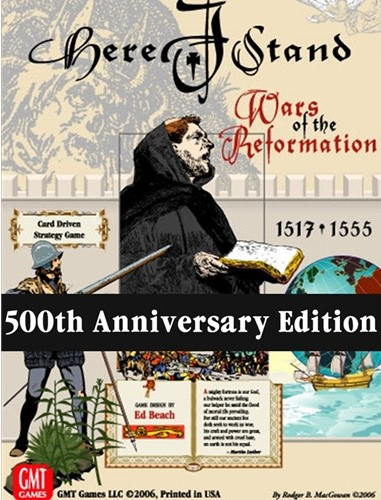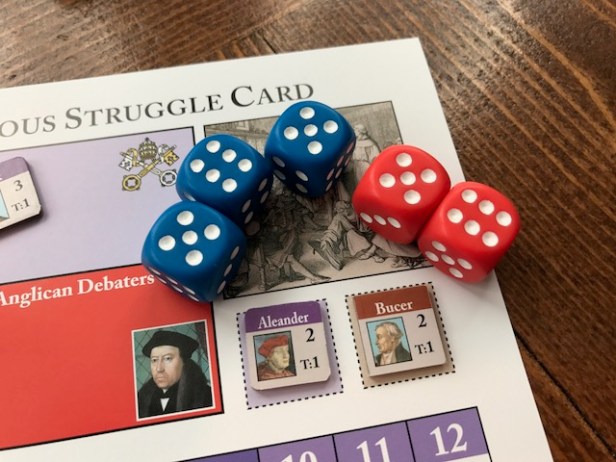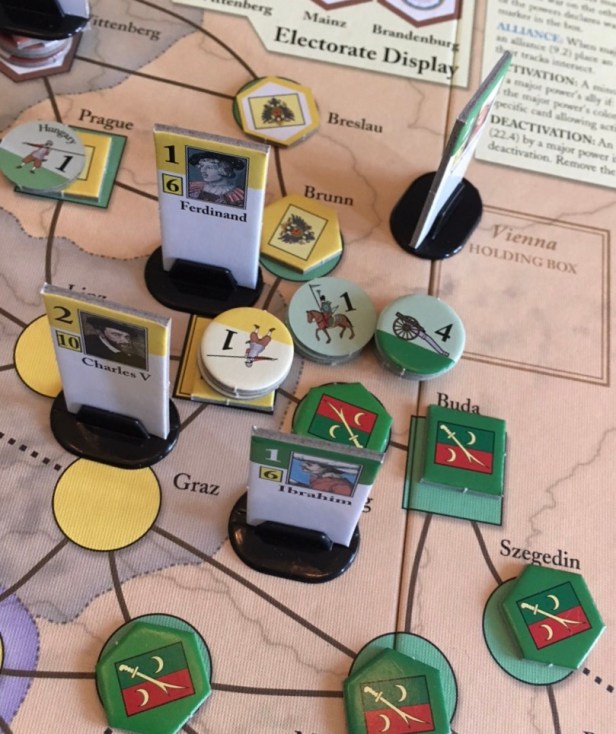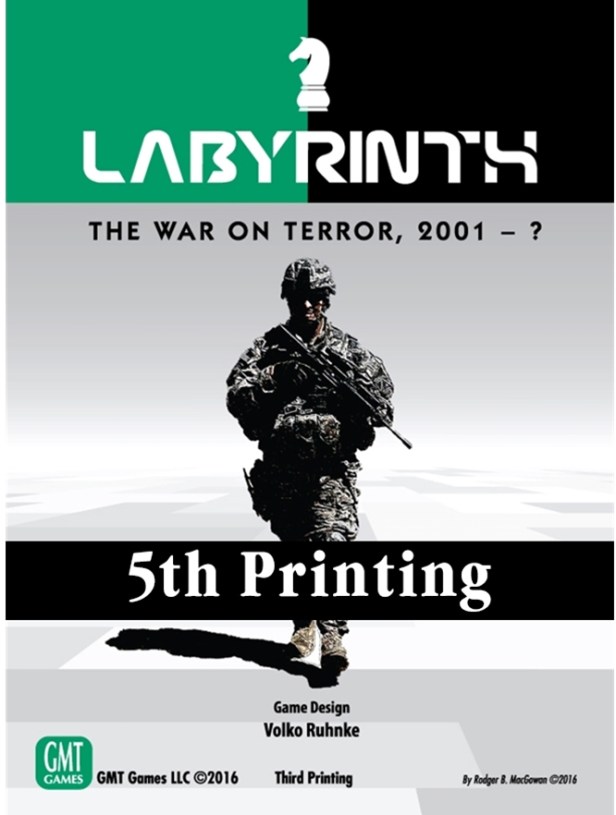Some of the first wargames that I experienced were Card Driven Games! Due to this fact, and because I really enjoy the mechanic, CDG’s hold a special place in my heart. So what is a Card Driven Game? It is more than just a game having cards or using cards. The CDG attempts to focus the players’ actions, and what they can ultimately do in the game, on the cards in their hand. Typically, performing some form of an action will use a single card and these cards will often be multi-purpose. This means they can be used for an action or to take the printed event on the card to do an action that typically either is more powerful but somewhat circumstantial. The medium also allows for historical events to be implemented in the game and allows various rules overhead or special instructions to be printed on the cards making the game a bit easier to play. Cards are simply fantastic and I have played many CDG’s. In fact, my first wargame was Twilight Struggle (yes I see it as a wargame!) followed by classics such as Wilderness War, Empire of the Sun, Washington’s War and others. In this entry in our Best Games with Series, I will take a look at Card Driven Games.
One final note before we go on. There are Card Assisted Games, such as Combat Commander, The COIN Series and others, that use cards as well but are not classified as CDG’s. In fact, I contend that one of the origins of CDG’s was the fantastic Up Front from Avalon Hill. But, CDG’s are a different breed and are treated as such in this post!

3. Twilight Struggle: The Cold War, 1945-1989 from GMT Games
Twilight Struggle is a two-player game simulating the forty-five year ideological struggle known as the Cold War between the Soviet Union and the United States which can be played in 2-3 hours. The entire world is the stage on which these two countries “fight” to make the world safe for their own ideologies and way of life. The game starts right after the end of World War II in the midst of the ruins of Europe as the two new “superpowers” of the world squabble over what is left and ends in 1989, when only the United States remained standing.
The map is a world map of the period, where players move units and exert influence in attempts to gain allies and control for their superpower. The beauty of the CDG system used here is that each decision of whether to use a card for the event or the operations value is a struggle as if it is the other side’s event, it might go off hurting you very badly. There are mechanics to allow for the removal of some of the best cards for your opponent in a side game within the game called The Space Race as well as nuclear tensions, with the possibility of game-ending global thermonuclear war (Shall we play a game, anyone?). I have played TS about 30 times and love it more and more with each sitting. The game makes me sweat, cringe, jump with joy and bite my fingernails. To me, a game that can do all of that in one sitting is worth the price.

I remember my first impressions of Twilight Struggle was that it needed some graphic design improvements and the game just didn’t grab me visually but that was all erased the first time we played as the topic and the mechanics just really spoke to me. This game is on this list because it really was our gateway to the CDG mechanic and I still have a real soft spot in my heart for it. I have played its successor called 1989: Dawn of Freedom and really enjoyed that game, which is in many ways, a bit better than TS but I still would rather play what I am comfortable with here.

2. Here I Stand: Wars of the Reformation, 1517-1555 (500th Anniversary Edition) from GMT Games
Here I Stand: Wars of the Reformation 1517-1555 is an experience packaged in a game that attempts to boldly cover the political and religious conflicts of early 16th Century Europe. The game focuses on the struggle of religious reformers such as Martin Luther, John Calvin and Ulrich Zwingli as they battle the Papacy for changes in their views of God and religion. But it is more than just the Holy War as it deals with the other European countries involved in the affairs of the time including France, England, the mighty Hapsburg Empire and the Ottoman Empire in the east. They all played a role in the process of the Reformation and the design brilliantly weaves this all together into an interesting and engaging experience. The game also covers the action of the period, including wars, marriages and ascendancies to thrones, using a unique Card Driven Game (CDG) system that models both the political and religious conflicts of the period on a single point-to-point map.
This CDG is really pretty basic when compared to some of the others on this list. The players all draw from a common deck of cards and the cards are mostly used for Operations Points to fuel each faction’s asymmetric menu of actions. But within this shared deck are really key historical events that are played with devastating effect. Also sprinkled in are various reaction cards and my favorite combat cards that will give the player various advantages from extra dice, to causing enemy stacks to lose units to the plague, dysentery or even desertion. These cards keep all of the players on the edge of their seats and really are well done and make this one very unique and feel very much more like a true wargame than other CDG’s.

Where the game is a bit divergent from other CDG’s is that each faction has a Home Card (or two in the case of the Papacy), which is really powerful and unique cards that are available each round to the power to use. The great thing about these cards is that every player knows what the other Home Cards can do and are aware of them throughout each round. They really add an air of uncertainty as well as some tension as they are really powerful. The other thing that I really like about the game is that each player has a different hand size and that hand size can grow and shrink as they faction is successful in the New World or continue to take over important cities called Keys. Players use this hand size to their advantage and some will play their less powerful cards early until their opponents run out of cards and then unleash hell with a few uncontested plays after others have passed. This is one of the best parts of the game and really makes a huge difference in how each player should paly their hands based on their circumstances of the board.

Finally, I love this game because of the player interaction, which includes making treaties, declaring war and also negotiations about what we desire other factions to do and how to go about their efforts to win. Cards can be traded in this game as part of these negotiations and I have always really liked this aspect. I say trading but the various events on these cards can also be trade bait as players can ask for or commit to either playing or not playing a certain card that would have a dramatic effect on an upcoming round. This take players who are comfortable with the system, the different factions and the victory conditions of the game but is such a juicy and exciting part of the design.
I just love Here I Stand, for a multitude of reasons but as a CDG it is one of the best at creating an experience.

1. Labyrinth: The War on Terror, 2001-? from GMT Games
Shortly after playing Twilight Struggle, I found myself furiously searching through the internet to try and find other games in that style/weight category I could sink my teeth into and before we knew it our shelves started filling up with games like Wilderness War, Churchill, and Labyrinth. Labyrinth piqued my interest because it was both a game that seemed to share a lot in common with Twilight Struggle but tackled both a contemporary, and also (for me at least) a very under-represented conflict. I’d played a number of WWII games, and other historical settings, but nothing that was contemporary, nothing that I had personally had some experience in or real world knowledge of.
Labyrinth: The War on Terror 2001-? was released in 2010, and covers the on-going conflicts all over the world between the USA and Islamic Jihadists. So, right off the bat you have a topic that will not be for everyone’s tastes, which is completely understandable. This is an ongoing topic of great polarization so I understand some people’s hesitation to get on board.
Labyrinth is a really interesting game from a mechanical standpoint. The cards function in a very similar way to the cards in Twilight Struggle, they are faction aligned (or neutral) and are used either for an event or OP’s values. Playing an opposing faction’s card triggers the event in much the same way and there is a way for each side to ditch a single card each hand, akin to the space race. That’s about where the similarities end however. In hindsight, I am very glad about this; that it wasn’t just a reskin but an entirely different style of game.

Like TS the players draw cards from a common stack, but the big difference is that each player plays two cards, effectively taking two turns before the other can react. The Jihadist player always goes first with the US playing a reactionary game. This does mean that the Jihadist player needs to be most comfortable with the rules before playing, because each game is only as good as the Jihadist can make it. A predictable Jihadist will make it easy for the US to mop them up. Unlike TS however there is no ‘legacy’ to the draw deck. Where Twilight Struggle adds more powerful cards to the deck as the early, mid and late war eras are played through; Labyrinth just has one monster stack. This means that whilst you can have an advantage knowing what cards there are in the deck, an experienced player will have a slightly smaller edge than in TS over a new player.
The factions in Labyrinth are completely assymmetrical. Unlike other games where factions within a game can break rules and create a-symmetry, Labyrinth provides two sides that use utterly different mechanics in order to achieve their entirely different victory conditions. At first I was leery of this fact, only because as a player you almost have to learn two different games in order to play both sides, but it works out extremely well, and which ever side you play first will give you an indication of the direction in which to utilize the other side.

At it’s heart Labyrinth is a cat-and-mouse game with the US as the cat and Jihadist player as mouse, trying to sew seeds of discontent and establishing Islamic Rule throughout the world. The US forces and abilities are extremely powerful, but bringing them to bear in many places and expeditiously is very difficult to do. It is incumbent upon the Jihadist player to try and spread the US out and get them bogged down in regime changes, as well as spending their high value cards to clean up terror plots instead of on working towards their own aims.
That was a look at my 3 Favorite Card Driven Games and yes I realize that they were all from GMT Games. I have played several others from other publishers, including games like Prelude to Rebellion: Mobilization and Unrest in Lower Canada, 1834-1837, Europe in Turmoil: Prelude to the Great War and Barbarians at the Gates from Compass Games but those on my list are superior in my opinion. This was extremely difficult to put together and I sweated over my choices. What Card Driven Games games are your favorites?
-Grant

Great choices! I also did my liste some time ago (https://theboardgameschronicle.com/2020/08/16/card-driven-games-cdgs-my-3-favorite/). More and more great titles designed in this genre every year!
LikeLiked by 1 person
Once I played a COIN game, I never went back to Labyrinth.
LikeLiked by 1 person
Interesting. I still love both COIN and Labyrinth. I get two totally different experiences from both.
LikeLike
A missing ‘hybrid’ proto-CDG from the list was AH’s ‘Up Front’.
LikeLiked by 1 person
I do love me some Up Front! It is not a true CDG as you mentioned but sure was one of the points of origin.
LikeLike
Im a warfighter combat commander guy…also like for the people
LikeLiked by 1 person
Im waiting on my copy of For the People to come off P500. Love Warfighter but it’s not really a CDG. Uses cards but not in the same way.
LikeLike
Pursuit of Glory. It’s Path of Glory ++
LikeLiked by 1 person
Grant, at some point will you be doing a list of CDG’s (and your faves) which came out after 1H2016?
LikeLiked by 1 person
What is 1H2016?
LikeLike
The table (“20+ Years…”) has games from 1994 to “1H2016” which I presume means “first half of 2016”. Hence CDG’s from then on are missing from it. Like Pax Pamir and many others. But maybe the table kind of threw me off, and you actually posted your top 3 of all time?
LikeLiked by 1 person
The list that I posted was my top 3 of all time!
LikeLike
Grant, Curious why you didn’t include the Undaunted Series either in your recent CDG video or in this post.
LikeLiked by 1 person
Because that series is not card driven. CDG’s need multiple uses including either an event or Ops value to use for actions. Undaunted uses cards but not in this way.
LikeLike
That table on top is awe-inspiring! So many good games in there. CDGs have really brought forward a new branch of the historical conflict gaming tree!
My personal top 3 are pretty similar to yours, Grant:
3. Wir sind das Volk!
2. Twilight Struggle
1. Here I Stand
But there are so many others of which I am also very fond – 13 Days, 1989, Hannibal, Labyrinth, Watergate… not even to mention my new discoveries Fire & Stone, Judean Hammer, or Votes for Women!
In short: CDGs are the best. All of them, kinda.
LikeLiked by 1 person
I would agree. I own Wir sind das Volk! but sadly have not been able to play it yet. Watergate is fantastic, as if Fire & Stone. So many great games that have branched off of the original CDG’s for sure. Thanks.
LikeLiked by 1 person
Great choices, but I would put HIS #1, TS #2, and not sure about #3
LikeLiked by 1 person
Does Command and Colors count? I’ll throw up C&C Napolianics and Time of Crisis.
LikeLiked by 1 person
In my narrow view no. C&C uses cards but in a different way.
LikeLike
I know it is more ‘scripted’ than most CDG and with usual Ted Racier multiple exceptions and suchlike but I have a real soft spot for and have always enjoyed play of Barbarossa to Berlin WW2.
LikeLiked by 1 person
What about Up Front?
LikeLiked by 1 person
It’s a fantastic game and was the Genesis for CDG’s but not strictly a CDG itself.
LikeLike